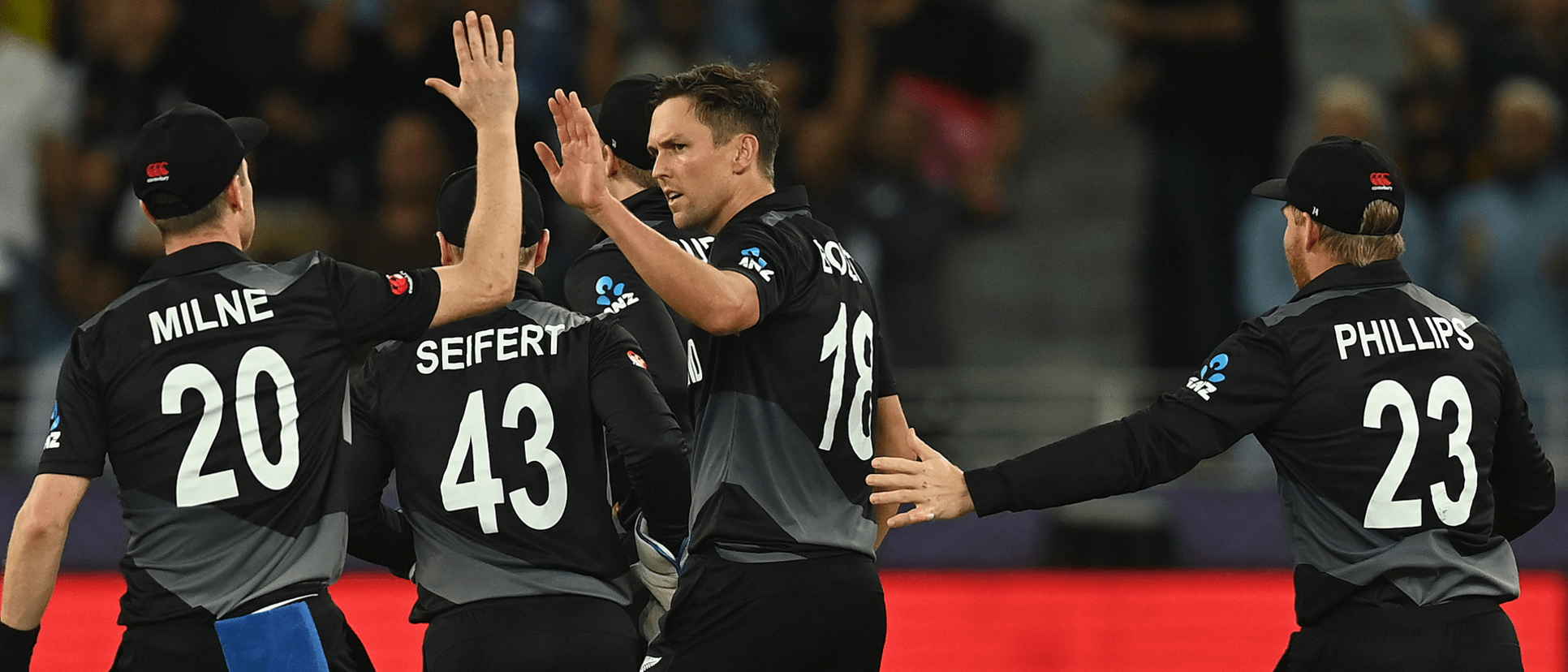New Zealand's best five performers on their road to the T20 World Cup final

Trent Boult was the go-to bowler for Kane Williamson in this year's World Cup. Despite bowling the tough overs inside the fielding restrictions and the death, Boult was New Zealand's highest wicket-taker and joint second-highest in the tournament overall, with 13 wickets at an economy of just 6.25 runs per over.
Known for his ability to produce terrific swing, Boult wasn't able to extract much movement in the conditions in the UAE but made up for it by bowling with pinpoint accuracy.
Trent Boult with a vital wicket for New Zealand
Having been hammered by Pakistan in their Super 12 opener, New Zealand needed to make a strong comeback in their next game against India. Boult set the ball rolling by dismissing Ishan Kishan inside the Powerplay. He then returned at the end to take the wickets of Hardik Pandya and Shardul Thakur to restrict India to 110, which they chased in just 14.3 overs.
He was amongst the wickets against Namibia and Scotland as well, picking up two each in both the matches. In a do-or-die clash against Afghanistan, he returned figures of 3/17, which included the important wicket of Najibullah Zadran, as Afghanistan limped to 124. The Black Caps chased it down with ease to secure a semi-final spot.
Having gone for his most expensive spell in the semi-finals against England (0/40), Boult hit back with figures of 2/18 (4) in the final; the only player to break through for the Black Caps.
Trent Boult's partner in crime, Tim Southee also enjoyed a splendid World Cup campaign. Though he only took eight wickets in six games, his splendid economy of 6.50 was only edged by Boult among the Kiwi bowlers, providing great control in the Powerplay and middle overs.
Though he picked up only a wicket each in New Zealand's first three games against Pakistan, India and Scotland, he was amongst the wickets leading up to the knockouts, picking up two wickets each against Namibia and Scotland.
Southee claims 100th T20I wicket
MT20WC_2021_MATCH19_PAKvNZ_NZ_5.1_SOUTHEE_100_WICKETS
In the must-win game against Afghanistan, he scalped the important wicket of Mohammad Nabi, who at that point, had strung a 59-run partnership with Zadran and were threatening to go big in the death overs. The wicket of Nabi derailed all the momentum as Afghanistan went from 115/4 to 134/8 at the end of the innings.
In the semi-final against England, while the rest of the bowlers went for runs, Southee finished with 1/24 in four overs, snaring the wicket of Dawid Malan who was starting to look dangerous.
Daryl Mitchell was the surprise package for New Zealand in this year's World Cup. Having never opened for his country before, Mitchell was pushed up the order to open the innings along with Martin Guptill. Despite batting in an unfamiliar position, he was one of three New Zealand players to pass 200 runs for the tournament.
Mitchell started the tournament well, scoring 27 and 49 runs against Pakistan and India respectively. That was followed by three scores of below 20 runs against Scotland, Namibia and Afghanistan.
He saved his best for when his team needed the most though, starring with a Player of the Match-winning 72* against England, batting through the innings to help his team chase down a target of 167 with an over to spare. Needing 20 to win off the last two overs, Mitchell finished things off in style with two sixes and a four to book New Zealand's berth in the final.
Daryl Mitchell hits vital fifty
James Neesham might have gone slightly under the radar in the World Cup, but played his role to perfection both with the bat and ball.
Playing the role of a finisher, he had a huge hand in New Zealand's wins over Namibia and England.
Walking in to bat when New Zealand were in a spot of bother at 87/4 in the 15th over, Neesham, along with Glenn Phillips, finished the innings off with a flurry. Punishing the Namibian bowlers for pitching full, Neesham raced to 35 off just 23 balls in difficult batting conditions to help New Zealand post a total of 163/4.
In the semi-final against England, New Zealand were staring down the barrel when Neesham came out to bat, still needing 61 from 29 balls. Neesham turned the game around in the 16th over, taking Chris Jordan to the cleaners with a 23-run over that changed the complexion of the match.
The game-changing over for New Zealand
Though he was at the crease for only 11 balls, his knock of 27 turned the game around for New Zealand. Neesham had another late flurry in the final, hitting 13* off just seven balls in a last-ditch cameo.
He has been quite handy with the ball too, with three wickets in seven matches.
Kane Williamson might have saved his best for the last but was consistent throughout for New Zealand, finishing as their highest run-getter.
After a sluggish 25 against Pakistan, he batted through to the end against India to chase down 110, scoring 33*. After a rare duck against Scotland, he returned to form with a 28 against Namibia and 42* in a virtual knockout against Afghanistan.
Kane Williamson's record-equalling knock
After scoring just 5 against England in the semi-finals, Williamson turned up in the final against Australia. He started slowly, scoring just 15 in his first 16 balls and even got a lifeline, thanks to Hazlewood who dropped a regulation catch.
He made full use of the reprieve and shifted through the gears after the drinks break, reaching his fifty in just 32 balls. He kept going even after reaching the milestone as he finished with 85 in just 48 balls.